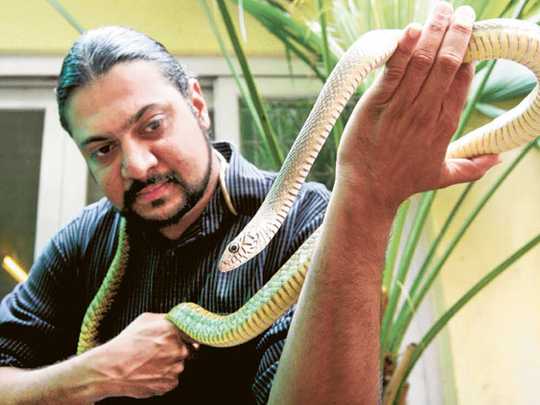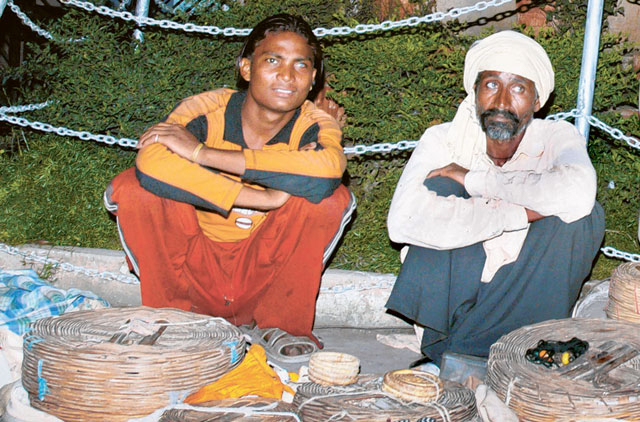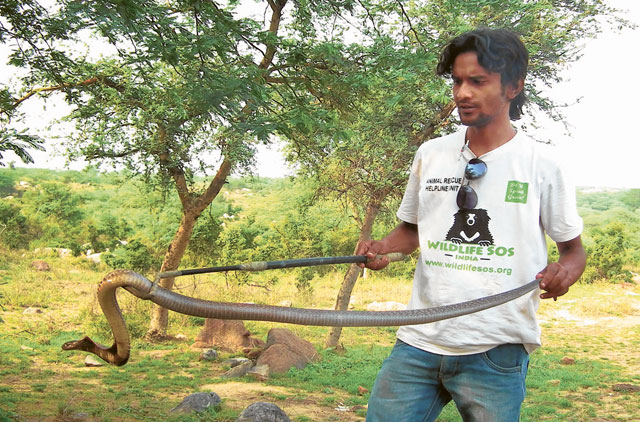
New Delhi: Sitting in a small room at Sapera Basti (village of snake charmers) in east Delhi, Munni and Guddu are busy playing a board game of snakes and ladders. Their grandfather Shambhu Nath was, incidentally, a snake charmer.
He smiles wryly reminiscing the days when he would walk the streets of cities and towns with cloth-covered baskets hanging from a bamboo pole slung across his shoulder. Hearing the sound of his been (flute-like instrument to charm the snakes), children would gather around him to see live snakes dance.
Snake charmers have few takers now. And Shambhu dislikes the fact that other interests including playing games on their mobile phones preoccupy children today. He feels that TV programmes on wildlife provide such in-depth information that children are no longer in awe of reptiles.
That's probably why the sights of snake charmers are increasingly rare. Shambhu has no snakes now. But then India too is no more referred to as the country of snake charmers. "Our culture has been sacrificed in the name of development. When it suits them, the government projects us as representatives of the Indian culture abroad, but back home our lives and livelihood are snuffed," Shambhu laments.
The enforcement of stringent wildlife laws by various animal-rights activists has left the likes of Shambhu with no option but to look for other means of earning a living. Only a few snake charmers wish to continue their legacy.
‘Lucky few'
Snake charmer, Karma Nath, says: "I am one of those whose snakes have been computer chipped. The chip acts as a name tag that gives a legal status to the owners. It has helped me ward off officials, who threaten to fine us under the laws designed to protect wildlife. Now no one can extract a bribe from me as I am not violating any law."
Dressed in a traditional saffron robe and a pagri (head gear), Karma says: "I was one of the lucky few who rushed to Delhi's Department of Forests and Wildlife office to comply with the deadline and got my three snakes micro chipped."
Goa-based environmentalist and herpetologist, Dr Nitin S. Sawant, who had been given the task by the Department of Forests and Wildlife said: "The activity was carried out under the amnesty scheme for the first and only time."
Keeping snakes was banned under the Wildlife Protection Act of 1972 and the Act was amended in 2002. The government introduced the amnesty scheme in 2003 and initiated a process with the hope of giving certificates to several hundred snake charmers, who owned snakes.
Legality issue
But only Karma and nine other snake charmers took advantage of the amnesty scheme. Kartick Satyanarayan, co-founder of Wildlife SOS, India, says: "The micro chip idea was only to ensure that a specific snake belonged to a charmer and that he had ‘declared' he inherited it. But the legality is an altogether different matter. The micro chip does not give them any legal sanction or authority to carry on with the trade of snake charming."
This technically means, if any snake charmer is continuing the business, it is in violation of the country's Wildlife Act. And if caught, they face a prison term of seven years. The laws aim to safeguard biodiversity by banning the possession, sale or trading of wildlife.
Sawant, the environmentalist, said: "Only 42 odd serpents had semi-conductors embedded under their skin. These included the Common Cobra, King Cobra, Rat Snake, Sand Boa and Python. The procedure was lengthy and it took 15 to 20 minutes to micro chip each snake."
The micro chips cost the government about $20 (Dh73.4) per snake and were embedded below the skin to escape the snake's molting process.
Kartick, who has worked extensively on wildlife animals detailed, "Micro chip, which is the size of a rice grain, remains an internal identification mark that is inserted under the skin. Each chip has a 13 digit unique identification number and can be read only by using a reader or a scanner. And if a snake charmer replaces a similar snake with the micro-chipped one, one can't tell."
The wildlife expert informed that depending on the species, the snakes could live from six years up to 60 years. But the ones snake charmers possess are highly unlikely to live long.
‘Like our children'
Animal lovers accuse snake charmers of confining the serpents into tiny baskets and ripping out their fangs. This is done periodically because the fangs grow back. And as a result many snakes die due to infection.
Janaki Lenin, a wildlife writer says: "Snake charmers defang the snakes with the hope that when the snake bites, it cannot inject any venom. But fangs can sometimes grow back and many snake charmers have died from supposedly defanged snakes."
"The venom of a snake is like saliva, which it produces all its life. One can milk a snake of venom by having it bite into a rubber covered beaker," she said.
However, Karma disputed this saying: "It is incorrect that we break their fangs. We make them venom-less by using a herb called jaharmora. Some snakes are extremely poisonous, but we treat them like our children. Since they provide us bread and butter, we regularly feed them milk, fish and chicken."
Mercenary approach
Kartick says: "That's one of the blunders the snake charmers resort to. Snakes are generally fed milk, which they cannot digest, as it is not their diet in the wild. Their staple diet is rats, birds and frogs, which, in captivity, they neither get nor can digest.
"Their digestive glands are removed because the venom glands, which have the fangs, are pulled out. The snake charmers take a blade and cut the gland out or puncture it with a red-hot iron needle so that no more venom is formed."
The wildlife expert divulged that snake charmers are very mercenary in their approach. "One cannot blame them, as that's the culture they have followed. But by trying to stick to that profession, they are harming not only the wildlife, but also their own future. They have to move on and take up other professions, because using the snakes has only disadvantaged their tribe further. It has kept them close to poverty and prevented them from joining the mainstream of society."
Wildlife SOS has been working toward rehabilitating the snake charmers for over a decade.
Kartick said: "We gave many, who were arrested by the police, the opportunity to earn a better living. It's time they stopped fooling ignorant people by concocting stories and spreading myths."














